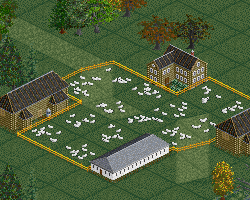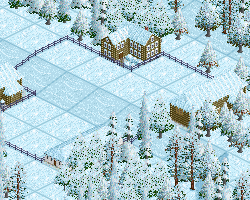ECS Agricultural Vector. Animal Farm
| << ECS Agricultural Vector. Fruit Plantation | ECS Agricultural Vector | ECS Agricultural Vector. Tinning Factory >> |
Valid for ECS 1.1
General data
Drawn by George, animals graphics by andythenorth, FooBar
The Animal farm is the part of the ECS Agricultural Vector.
Cargoes
Accepting
The Animal farm accepts Fish, Cereals and Fibre crops.
Note: One of the Animal farm layouts (with chicken farm graphics) does not accept Fibre crops.
The Animal farm does not accept any cargo during first 93 days of life if built in game.
The Animal farm does not accept any cargo if it is in town zone 0.
Cargo acceptance is limited by storage capacity. If the stockpile is in overflow, the overflowing cargo is accepted and immediately removed from the store into nowhere.
| Level | Fish | Cereals | Fiber crops |
|---|---|---|---|
| Very low | 173 | 293 | 510 |
| Low | 328 | 556 | 969 |
| Normal | 623 | 1056 | 1841 |
| High | 1183 | 2006 | 3498 |
| Very high | 2248 | 3812 | 6646 |
| Ultimate | 4271 | 7243 | 12628 |
Production
The Animal farm produces Livestock and Wool.
The Animal farm does not produce any cargo during first 93 days of life if built in game.
The Animal farm uses 6 production levels.
The Animal farm production is calculated according to the production level and amount of animals and based on values in the table (production data is calculated for 8 cycles a month. During game play, there are 8 or 9 cycles, while the total amount of distributed cargo is adjusted with property for minimal amount of cargo distributed). The production in the table is calculated with assumption that amount of animals is equal to value in the table. In fact this amount changes every cycle.
The amount of produced livestock is subtracted from amount of animals, new animals appear with a factor of 555/553. If there is not enough fodder to feed the animals, the additional amount of livestock is produced (and the total amount of animals is reduced). If there is too much fodder (any fodder storage overflow), the amount of animals is increased by 33% of this fodder.
Processing of fodder goes as % of number of animals. Values for calculating fodder from cargos are represented in the table (according to the specified amount of animals). The most stored cargo (counted as % of storage) is processed first. Additionally, when the animal farm is not covered with snow, animals and farmers gather fibre crops themselves. Amount of fibre crops, gathered by animals is calculated as % of number of animals. Amount of fibre crops, gathered by farmers, is fixed and represented in the table. 5802 animals exist on the farm from the beginning.
The table is calculated for the number of heads from the second table
| Level | Livestock (items) | Wool (items) | Fish | Cereals | Fiber crops |
|---|---|---|---|---|---|
| Very low | 50 | 102 | 91 | 81 | 71 |
| Low | 95 | 195 | 174 | 153 | 136 |
| Normal | 181 | 370 | 330 | 291 | 258 |
| High | 343 | 702 | 627 | 553 | 490 |
| Very high | 652 | 1334 | 1192 | 1051 | 931 |
| Ultimate | 1238 | 2535 | 2265 | 1997 | 1769 |
Production change
Production change happens on the 1-st day of every month.
The Animal farm does not change production level during first 93 days of life if built in game.
On the lowest production level (Very low or 3%) advanced closure mechanism is applied with the following protection conditions:
- last one on the map
- younger than 5 years for industries, built in SE (scenario editor) or during map generation, younger than 2 years for others
- transportation level > 75%
Protection can be changed with a parameter of ECS Agricultural Vector to the following protection conditions:
- last one on the map
- younger than 5 years for industries, built in SE (scenario editor) or during map generation, younger than 2 years for others
- transportation level > 1%
- Animal farm was built by the player during game play
Changing production level is calculated by comparing the number of animals with the value, represented in the table. If it is more than -25% from the next level, it is increased. If it is less than +25% of the previous level, it is decreased.
The industry can increase production level by one or two, and decrease it to any level.
| Level | -25% | Heads | +25% |
|---|---|---|---|
| Very low | 1280 | 1707 | 2134 |
| Low | 2432 | 3243 | 4054 |
| Normal | 4620 | 6160 | 7700 |
| High | 8778 | 11704 | 14630 |
| Very high | 16679 | 22238 | 27798 |
| Ultimate | 31689 | 42252 | 52815 |
On normal production level and higher at list 50% of cargo should be transported to allow production level growth
Attention! If the industry is inside a town zone ???, it always generates a "decrease production" event.
Construction
The Animal farm has one of 3 possible layouts. New layouts are welcome (:biggrin:)
The Animal farm has high probability (7) to be built by map generator and low probability (2) to be built during game play.
The Animal farm can be built by a player both in a game and in the scenario editor. Construction cost factor is 104. Construction conditions are represented in the table.
When built by the player during a game, the Animal farm will be in company colours of the builder. When generated by the game or built while in the scenario editor, the Animal farm will pick up the colour randomly.
| SE | Condition |
|---|---|
| Build on dry land | |
| Build > 1 tiles away from shore tile | |
| Build < 25 tiles away from shore tile | |
| Build > 3 tiles away from desert tile | |
| Build at least 1 tile away from Tz0 | |
| Build > 31 tiles from a Farm | |
| Build > 31 tiles from a Fishing grounds | |
| Build > 31 tiles from a Tinning factory | |
| Build > 31 tiles from a Textile mill | |
| Build > 15 tiles from an Animal farm |
Description of Location/Positioning Conditions
Features
The Animal farm is covered with snow when located above snow line. The Animal farm supports company colours.
The Animal farm can be build on sloped land.

